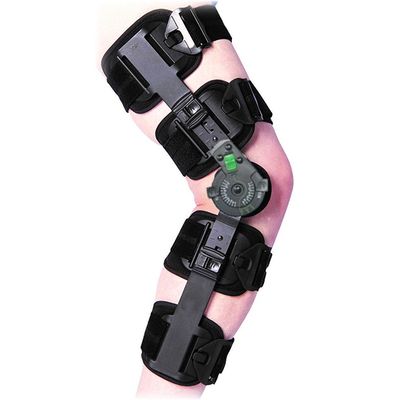Trend ROM Hinged Knee
The Trend ROM Hinged Knee is an adjustable range of motion orthosis that stabilizes the knee for patients suffering from mild to moderate strains, sprains, or ligament tears. Our Trend TX2 Moisture Wicking Neoprene provides support and compression while also being lightweight and breathable. Sized and universal options are available for a customized contoured fit.
-
PDAC Approved Codes
- L1832
- L1833
-
Key Features
- Provides post-injury protection, compression, and support
- Front closure wraparound
- Trend TX2 Moisture Wicking Neoprene provides a custom contoured fit
- Rubber tabs allow easy re-adjustment and application
- Easy to use controlled range of motion hinge
-
Indications
- Mild to moderate ACL, PCL, MCL, and LCL Sprains
- Meniscal or patellar instabilities
- Mild osteoarthritis
- Mild knee sprains and strains
-
Sizing Guide
- DC-032 (Up to 28”) UNIVERSAL
- DCT-002-1 (Up- 15”) XS
- DCT-002-2 (15- 18”) S
- DCT-002-3 (18- 21”) M
- DCT-002-4 (21- 24”) L
- DCT-002-5 (24- 26”) XL
- DCT-002-6 (26- 28”) 2XL
- DCT-002-7 (28- 30”) 3XL
Key Features of a Hinged Knee Orthosis:
- Adjustable Range of Motion (ROM):
- Allows controlled flexion and extension of the knee to aid in gradual recovery.
- Often has dial locks or stops to set specific degrees of motion restriction.
- Stabilization and Support:
- Reinforces the knee joint, preventing excessive lateral movement.
- Reduces strain on injured ligaments or post-operative structures.
- Hinged Mechanism:
- Mimics natural knee movement while preventing hyperextension.
- Can be single-axis or polycentric hinges for improved biomechanics.
- Comfortable and Adjustable Fit:
- Features adjustable straps, cushioned liners, and breathable materials.
- Designed for long-term wear without discomfort.
Common Uses of Hinged Knee Orthoses:
- Post-surgical recovery (e.g., ACL reconstruction, meniscus repair).
- Ligament injuries (ACL, MCL, PCL, LCL sprains or tears).
- Osteoarthritis relief (offloading knee pressure).
- Sports injury prevention (especially in high-impact sports).
- Patellar stabilization (for conditions like patellar subluxation).

Order Online Your Orthopedic Brace or Splint
Braces, while also used for stabilization, serve a slightly different function. They are more flexible than splints and are designed to provide support through compression rather than full immobilization. Braces are often used for ongoing support during recovery or for chronic conditions like arthritis. Constructed from materials such as neoprene, elastic, or cotton, braces may also incorporate metal components for added reinforcement, but their primary function is to allow controlled movement while preventing overextension or strain.
A splint is a medical device used to stabilize and protect an injured joint, bone, or soft tissue, helping to promote healing by restricting movement and preventing further damage. Splints can vary in rigidity based on the nature of the injury. Rigid splints are often made from materials like plastic, metal, or fiberglass, providing firm immobilization for more severe injuries such as fractures. Soft splints, on the other hand, are typically made from materials like foam or fabric and are used in cases requiring more flexibility, such as sprains or strains, where complete immobilization is unnecessary.









